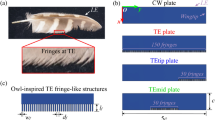Abstract
While the leading-edge serration in owls’ wing is known to be responsible for low noise gliding and flapping flights, the findings on its aero-acoustic role have been diverse or even controversial. Here we present an experimental study of the morphological effects of leading-edge serrations on aerodynamic force production by utilizing owl-inspired, single-feather, clean and serrated wing models with different serration lengths and spacing, and by combining Particle Image Velocimetry (PIV) and force measurements. Force measurements show that an increase in the length and density of the leading-edge serrations leads to a reduction in the lift coefficient and lift-to-drag ratio at Angles of Attack (AoAs) < 15° whereas the clean and serrated wings achieve comparable aerodynamic performance at higher AoAs > 15°, which owl wings often reach in flight. Furthermore PIV visualization of the flow fluctuations demonstrates that the leading-edge serration-based mechanism is consistent in all serrated wing models in terms of passive control of the laminar-turbulent transition while at AoAs > 15° similar suction flow is present at leading edge resulting in a comparable aerodynamic performance to that of the clean wing. Our results indicate the robustness and usefulness of leading-edge serration-inspired devices for aero-acoustic control in biomimetic rotor designs.
Similar content being viewed by others
References
Bachmann T, Blazek S, Erlinghagen T, Baumgartner W, Wagner H. Nature-Inspired Fluid Mechanics. Notes on Numerical Fluid Mechanics and Multidisciplinary Design, Springer, Berlin, Germany, 2012, 101–117.
Graham R R. The silent flight of owls. Journal of the Royal Aeronautical Society, 1934, 38, 837–843.
Bachmann T, Klän S, Baumgartner W, Klaas M, Schröder W, Wagner H. Morphometric characterisation of wing feathers of the barn owl Tyto alba pratincola and the pigeon Columba livia. Frontiers in Zoology, 2007, 4, 1–15.
Lilley G M. A study of the silent flight of the owl. 4th AIAA/CEAS Aeroacoustics Conference, Toulouse, France, 1998, 1–6.
Kopania J. Acoustics parameters the wings of various species of owls. Inter-Noise, Hamburg, Germany, 2016, 2868–2876.
Weger M, Wagner H. Morphological variations of leading- edge serrations in owls (Strigiformes). PLoS ONE, 2016. 11, 1–21.
Wagner H, Weger M, Klaas M, and Schröder W. Features of owl wings that promote silent flight. Interface Focus, 2017. 7, 1–11.
Rao C, Ikeda T, Nakata T, Liu H. Owl-inspired leading-edge serrations play a crucial role in aerodynamic force production and sound suppression. Bioinspiration & Biomimetics, 2017, 12, 1–13.
Schwind R G, Allen H J. The effects of leading-edge serrations on reducing flow unsteadiness about airfoils, an experimental and analytical investigation. NASA-CR-2344, 1973.
Hersh A S, Hayden R E. Aerodynamic sound radiation from lifting surfaces with and without leading-edge serrations. NASA-CR-114370, 1971.
Hersh A S, Soderman P T, Hayden R E. Investigation of acoustic effects of leading-edge serrations on airfoils. Journal of Aircraft, 1974, 11, 197–202.
Ito S. Aerodynamic influence of leading-edge serrations on an airfoil in a low Reynolds number: A study of an owl wing with leading edge serrations. Journal of Biomechanical Science and Engineering, 2009, 4, 117–122.
Cranston B, Laux C, Altman A. Leading edge serrations on flat plates at low reynolds number. 50th AIAA Aerospace Sciences Meeting Including the New Horizons Forum and Aerospace Exposition, Nashville, USA, 2012, 1–14.
Chen W, Qiao W, Wang X, Wang L, Tong F. An experimental and numerical investigation of airfoil instability noise with leading edge serrations. 22nd AIAA/CEAS Aeroacoustics Conference, Lyon, France, 2016, 1–23.
Sarradj E, Fritzsche C, Geyer T. Silent owl flight: Bird flyover noise measurements. AIAA Journal, 2011, 49, 769–779.
Geyer T, Sarradj E, Fritzsche C. Silent owl flight: Acoustic wind tunnel measurements on prepared wings. 18th AIAA/CEAS Aeroacoustics Conference, Colorado Springs, USA, 2012, 1–17.
Geyer T F, Claus V T, Sarradj E. Silent owl flight: The effect of the leading edge comb on the gliding flight noise. 22nd AIAA/CEAS Aeroacoustics Conference, Lyon, France, 2016, 1–12.
Geyer T F, Wasala S H, Cater J E, Norris S E, Sarradj E. Experimental investigation of leading edge hook structures for wind turbine noise reduction. 22nd AIAA/CEAS Aeroacoustics Conference, Lyon, France, 2016, 1–13.
Narayanan S, Chaitanya P, Haeri S, Joseph P, Kim J W, Polacsek C. Airfoil noise reductions through leading edge serrations. Physics of Fluids, 2015, 27, 025109.
Chaitanya P, Narayanan S, Joseph P, Vanderwel C, Kim J W, Ganapathisubramani B. Broadband noise reduction through leading edge serrations on realistic aerofoils. 21st AIAA/CEAS Aeroacoustics Conference, Dallas, USA, 2015, 1–29.
Chaitanya P, Narayanan S, Joseph P, Kim J W. Leading edge serration geometries for significantly enhanced leading edge noise reductions. 22nd AIAA/CEAS Aeroacoustics Conference, Lyon, France, 2016, 1–19.
Sakai M, Sunada Y, Rinoie K. Three-dimensional separated flow on a flat plate with leading-edge serrations. 53rd AIAA Aerospace Sciences Meeting, Kissimmee, USA, 2015, 1–13.
Klän S, Klaas M, Schröder W. The influence of leading edge serrations on the flow field of an artificial owl wing. 28th AIAA Applied Aerodynamics Conference, Chicago, USA, 2010, 1–9.
Winzen A, Roidl B, Klän S, Klaas M, Schröder W. Particle- image velocimetry and force measurements of leading- edge serrations on owl-based wing models. Journal of Bionic Engineering, 2014, 11, 423–438.
Klän S, Bachmann T, Klaas M, Wagner H, Schröder W. Experimental analysis of the flow field over a novel owl based airfoil. Experiments in Fluids, 2009, 46, 975–989.
Acknowledgment
This study was partially supported by an endowed project by Teral Inc., Japan. Hao Liu and Toshiyuki Nakata were partly supported by the Grant-in-Aid for Scientific Research on Innovative Areas (No. 24120007), the JSPS, and the Tough Robotics Challenge - Impulsing Paradigm Change through Disruptive Technologies Program (Cabinet Office, Government of Japan), JST. Chen Rao acknowledges the financial support from a Japanese Government MEXT scholarship. Special thanks are extended to the Yamashina Institute for Ornithology for providing the feathers of an Ural owl.
Author information
Authors and Affiliations
Corresponding author
Rights and permissions
About this article
Cite this article
Ikeda, T., Ueda, T., Nakata, T. et al. Morphology Effects of Leading-edge Serrations on Aerodynamic Force Production: An Integrated Study Using PIV and Force Measurements. J Bionic Eng 15, 661–672 (2018). https://doi.org/10.1007/s42235-018-0054-4
Published:
Issue Date:
DOI: https://doi.org/10.1007/s42235-018-0054-4



